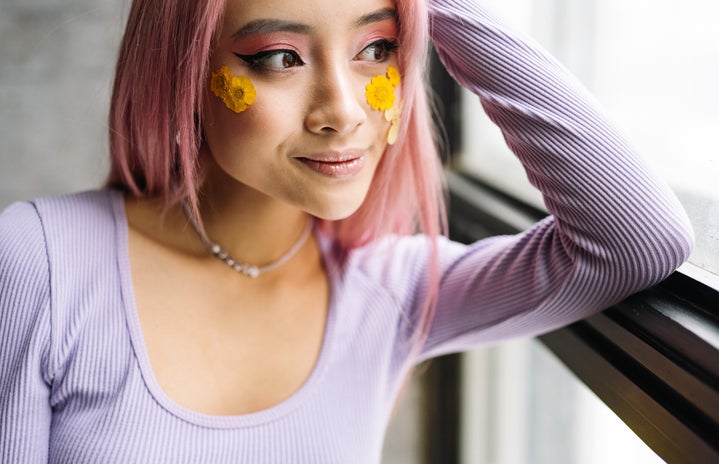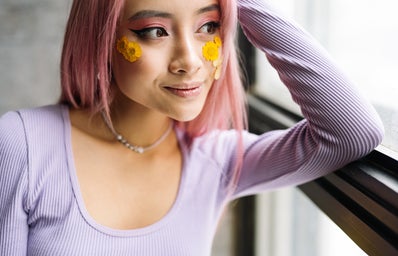It was 2 a.m. and I hadn’t stopped scrolling for what seemed like an eternity. I laid on my side, my arm tucked under the pillow and phone in hand. My fingers felt weak, my eyes were strained, and my eyelids were heavy, but not enough to shut them and fall asleep. This is what it was like during the few, short months when I was using TikTok.
I remember downloading TikTok at the behest of my closest friends who would text me links to TikTok videos they thought were funny. They’d sit in our dorm room, follow along with popular dance tutorials, use silly filters, and all. So, after persistent coaxing, I decided to download the app.
At first, TikTok was fun. My For You Page (FYP) contained a continual stream of topics I was interested in: painting, photography, things to do and places to eat in New York City, cinematic shots of California to remind me of home, skateboarding, surfing, and everything else under the sun. While scrolling through TikTok, I felt like I was a part of a community, even though I never actively commented or posted my own content.
Like most things, scrolling through TikTok was enjoyable when done in moderation, but over time, things changed. When I first downloaded TikTok, I’d only scroll for a few minutes a day — maybe ten at most — but once the spring semester ended and summer break rolled around, I found myself spending all of my lazy evenings on the app.
Gradually, TikTok started to become a problem for me. Using it made me feel physically ill. Headaches, eye strains, and a general sense of dissatisfaction with life were all common symptoms of my overuse. I was averaging 1.5 to 2 hours a day (the max time I ever spent on TikTok was four hours in a day). Eventually, I recognized that this excessive social media consumption wasn’t safe for me on a daily basis — or anyone, for that matter.
Research demonstrates an ongoing connection between social media and mental health.
A 2019 study published in JAMA Psychiatry found that American adolescents who spend more than three hours per day on social media may be at heightened risk for mental health issues — regardless of their mental health status prior to app use. A 2020 report published in Nature suggests that frequent social media users may be at higher risk for anxiety and depression and notes that rates of teen depression began rising around 2012 — coincidentally when social media first became popular. Social media use has also been linked with poor sleep quality and low self-esteem; but still, creators continue to scroll.
In a recent survey conducted by The Reboot Foundation, participants were asked about their views on social media as they relate to mental health. Shockingly, the report showed that about 40% of social media users would rather give up their pet or car before they’d give up their social media accounts, and 70% of users said they would not permanently delete their social media for anything less than $10,000. These findings — coupled with stats from the Substance Abuse and Mental Health Services Administration (SAMHSA) about depression and teens — demonstrate why scrolling through TikTok may be more addictive and harmful than you think.
TikTok can help you find community, but it can also make you feel more isolated.
While social media can be a great tool for building community, it has also been linked with lower self-esteem in university students and has a tendency to breed a culture of comparison, leading users to feel more isolated.
In the American Medical Association’s “What Doctors Wish Patients Knew” series, two physicians — Nusheen Ameenuddin, MD, MPH, and Carl Streed, MD, MPH — discussed the potentially hazardous effects of social media. Dr. Streed noted that often, users are “presenting their best self, their best lives or best versions of their lives,” which can exacerbate FOMO for other social media users and perpetuate a culture of comparison. “That constant comparison when people are scrolling is believed to lead to harm,” he says.
Social media use also increased during COVID-19, with many teens, young adults, and older adults finding more time to scroll endlessly (Statista reports that the average social media time for U.S. users increased to 65 minutes daily, compared to 54 the year before). Not only did the pandemic highlight stark disparities and class differences in America and beyond, but these disparities translate to social media, too. Whereas some people’s lives didn’t change much — or even got better — during the pandemic, others lost everything from loved ones to jobs, their homes, and more. Scrolling on social media and naturally comparing your lifestyle to someone else’s can feel like putting salt in a wound. “Comparing who has the better outfit or house…can actually be a trigger that can lead to decreased mood,” Dr. Ameenuddin says.
tiktok comes with a unique set of issues.
To be fair, TikTok is a social media platform unlike any other. The app has been a game-changer for entertainers and small businesses, and many emerging comedians and singers have used the platform to gain exposure. For comics and artists who were once living in the basement of their NYC apartment and working at a cafe in the daytime, showcasing their work online has given them the opportunity to instantly “go viral.”
Even so, TikTok can be problematic. The app has a history of restricting and shadowbanning LGBT hashtags, terms, and users, and many Black creators have since moved on from TikTok after having their videos about racial injustice, rights, and art suppressed and shadowbanned by the algorithm. There has even been controversy over how TikTok funds its creators; most only receive a fraction of the money that they should be getting based on their number of views (see Hank Green’s YouTube video “So…TikTok Sucks” for a firsthand account of this).
When I joined TikTok initially, it felt like I was part of an online community with people who shared my interests. But over time, my TikTok FYP revealed a painful truth: If I wasn’t attractive enough, I’d most likely never have a seat at the table. There are many talented users on the platform, but not many of them reach the level of fame that famous creators like Charli D’Amelio or Addison Rae did overnight. The more I used TikTok, I couldn’t help but feel insecure on the app as an artist — I felt like my own art would never be seen. This, along with acknowledging the problems and issues of the algorithm’s preferences for specific groups, led me to eventually stop using the app.
The more I used TikTok, the more I wondered how else I could be spending my time.
While scrolling through TikTok, existential questions nagged at me. I’d watch people on the app and think, What are they doing with their lives? What am I doing with mine? I realized that this passive ingestion of other people’s lives was leading to an unhealthy buildup of FOMO. Instead of caring what other people think of me, or caring about how my life compares to theirs, I decided to remove this source of jealousy and comparison entirely.
Apple’s app-use metrics helped me realize how detrimental using TikTok was for me, and how sickly my codependency on social media was becoming. With each passing week, I saw my use of TikTok, Instagram, and Snapchat remain the same as the week before — or increase ever so slightly. With 1-2 hours each day, I could’ve been reading a book or working on my organic chemistry homework — but instead, I was scrolling. Couldn’t I dedicate these hours of downtime to something more useful, like reading a book, catching up on the news, or volunteering at a community center?
Over time, I stopped caring about what was happening online, and more about real life.
It has been over a year since I last used the app. Now, I feel a lot healthier in mind and body. I’ve distanced myself from fleeting trends. As a pharmacy student in my first professional year, letting go of TikTok has allowed me to devote my free time to school. I’d like to think that in the absence of TikTok, I have a better attention span, too, or at least an easier time sleeping.
My instinct to open TikTok — even when there was nothing to be gained — was unlearned slowly but surely, little by little. Eventually, I forgot the app was installed and I stopped caring about the newest, funniest trends my friends were sending me. I disabled TikTok notifications, and for a few weeks, the app sat untouched and unopened on my phone. At some point, my phone storage was so low that my phone removed TikTok on its own. It now has a little cloud symbol next to it, waiting for me to reinstall it. Today is not that day.
Studies
Haidt, J., & Allen, N. (2020). Scrutinizing the effects of digital technology on mental health.
Riehm, K. E., Feder, K. A., Tormohlen, K. N., Crum, R. M., Young, A. S., Green, K. M., … & Mojtabai, R. (2019). Associations between time spent using social media and internalizing and externalizing problems among US youth. JAMA Psychiatry, 76(12), 1266-1273.
Twenge, J. M., Martin, G. N., & Spitzberg, B. H. (2019). Trends in US Adolescents’ media use, 1976–2016: The rise of digital media, the decline of TV, and the (near) demise of print. Psychology of Popular Media Culture, 8(4), 329.


